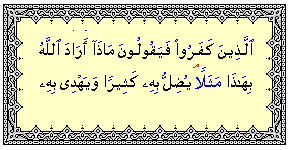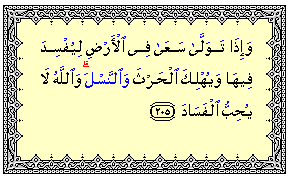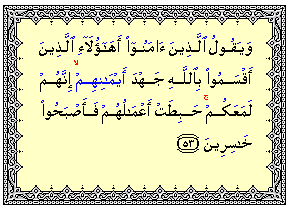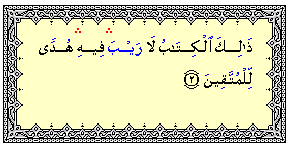In this great month of Ramadan, people will be reciting the Qur’an more, insha’Allah. While we recommend everybody to get a colour-coded Arabic-text mushaaf–because it makes it easy to recite with 100% perfect tajweed once you learn the rules–sometimes, deciphering some of the symbols can be a bit tricky.
In this first post, we’re going to insha’Allah discuss different stops in the mushaf. You may have seen these stop symbols: tiny little letters (meem, qaaf+lam, jeem, saad+lam, lam+alif) written above the text. These five correspond roughly to the five ahkaam taklifee–fard, mustahab, mubah, makrooh, and haraam.
Meem Stop: The meem stop looks like a tiny letter meem. Here’s an ayah with a meem stop (red meem above the blue word):

A meem-stop is like a fard thing; you have to stop on that word. You cannot continue. So stop!
Qaf-Lam Stop: The qaf-lam stop looks like the letters qaf and lam joined together with a little squiggly line underneath. Here’s an ayah with it:

The qaf-lam stop is like a mustahab/sunnah thing; you don’t have to stop, but it’s better if you do. So stop!
Jeem Stop: The jeem stop is a small jeem. Here’s an ayah with it:

The jeem stop is like a mubah thing; you can stop or not stop, there’s no recommendation either way. It’s up to you if you want to stop or not. (Maybe they put it in to show that you can stop there; us non-Arabs, how would we know otherwise where we can stop, without butchering the text?)
Saad-Lam Stop: The saad-lam stop looks like the qaf-lam stop (except with a saad instead of a qaf)–it has a little squiggly line underneath. Here’s an ayah:

The saad-lam stop is like a makrooh thing; you can stop, but it’s recommended you don’t stop. (It’s not really a stop, more like an anti-stop, an “ok, you can stop, but it’s better if you don’t.”) This is similar to a makrooh action, where you get no sin for doing it, but a reward for avoiding it.
Lam-Alif Stop: The lam-alif stop is really the word “laa,” meaning “No!” Here’s an example:

The laa stop is like a haraam thing (sort of). You DON’T stop there! Why? If you stop in it, it can change the meaning. In fact, the meaning can become kufr!
The most obvious example of this is in Surah Baqarah:

In this verse, there’s a lam after “yukhaadi’uwna Allaha.” Why? If you stop there, it means “they (think to) deceive Allah.” Is it possible to deceive Allah, the All-Knowing? No!
Edit: There seems to be some sort of difference of opinion about this; however, both opinions are authentic and are backed by scholars. For more details, please consult with a shaykh of Tajweed.
The final stop is, well, a triangle stop. The triangle stop looks like a triangle made up of three dots, like so:

You can see that there are two of these guys–they always work in pairs. One is over the word “rayba,” and one is over “fiyhi.” It’s a mubah stop; you can stop, or not stop; but if you stop, stop at either one of the words, NOT both!
So in this example, you can stop after “rayb.” That would give this verse the meaning: “This is the book without doubt; in it is guidance for the believers.” If you stopped after the second word, “fiyhi,” you get: “This is the book with no doubt in it; guidance for the believers.” Kinda similar, kinda different!
Before we conclude, we’d like to reiterate: we are NOT saying it’s fard, haram, etc. to stop or not stop in certain places. Rather, we are likening the possibility of “stop” or “don’t stop” to the ahkaam taklifee, which everyone is familiar with.
And that sums up the stops in the mushaf! Learn them, know them, and do what you can; in the end, reciting is ibaadah, and it’s hard, but insha’Allah you get lots of reward for doing it.